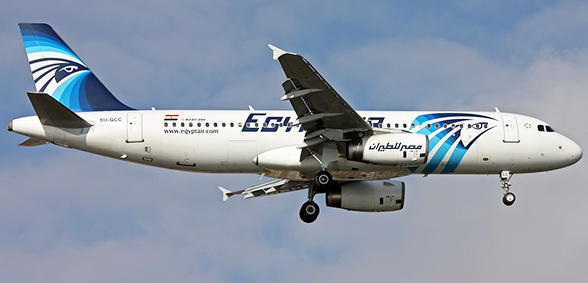
Egyptian authorities have yet to release a final report on the May 2016 crash of EgyptAir Flight 804 into the Mediterranean Sea, but France’s accident investigation agency Friday took the unusual step of announcing that it believes the most likely scenario is that a fire broke out in the cockpit and spread rapidly, resulting in a loss of control and subsequent crash. All 66 people aboard the Airbus A320 flying a scheduled service from Paris to Cairo were killed in the accident.
The Bureau d’Enquêtes et d’Analyses pour la Sécurité de l’Aviation civil, or BEA, apparently is frustrated that more progress has not been made in the accident investigation. “The BEA is ready to continue its collaboration with its Egyptian counterpart should the latter restart the safety investigation into this accident,” the BEA said.
In compliance with international standards laid out in the International Civil Aviation Organization’s Annex 13, Aircraft Accident and Incident Investigation, a safety investigation was started immediately after the May 19, 2016, accident. The airplane crashed in international waters, but Egypt took charge of the investigation because it is the state of registry and state of the operator of the airplane. The BEA appointed a representative to the investigation, assisted by technical advisers from Airbus, because France is the state of design of the airplane. The United States, through the National Transportation Safety Board, also was represented as the state of the engine manufacturer.
The flight recorders were recovered and sent to France for repair so that data could be recovered. In July 2016, data from the two recorders was extracted, read and decoded, BEA said.
During this work, Egyptian authorities released some information about the accident, specifically that:
- The flight recorders stopped operating while the aircraft was in cruise at 37,000 ft;
- The aircraft sent aircraft communications, addressing and reporting system (ACARS) messages indicating the presence of smoke in toilets and in the avionics bay;
- The playback of the cockpit voice recorder revealed that the crew mentioned a fire on board the aircraft; and,
- Some of the debris recovered from the accident site showed signs of having been subjected to high temperatures.
The BEA added that a signal from an emergency locator transmitter was sent about eight minutes after the transmission of the last ACARS message and that data from a Greek primary radar shows that the airplane descended in a turn until it collided with the surface of the water.
“Based on these elements, the BEA considers that the most likely hypothesis is that a fire broke out in the cockpit while the aeroplane was flying at its cruise altitude and that the fire spread rapidly, resulting in the loss of control of the aeroplane,” the BEA said.
But in December 2016, Egypt’s aircraft accident investigation committee announced the discovery of traces of explosive on recovered human remains and said that, in accordance with Egyptian law, this finding led it to transfer the case to the Egyptian attorney general, who would be responsible for carrying out the investigation.
The BEA said that its proposals concerning further work on the debris and recorded data were not followed up, and that technical elements of the investigation already collected by Egypt, including those provided by the BEA, are “protected by the Egyptian judicial investigation.”
In an effort to continue the safety investigation, BEA representatives met with the attorney general in May. At that time, Egyptian authorities explained that because it had been determined that there had been a malicious act, the investigation now fell within the sole jurisdiction of the judicial authorities.
“The BEA’s Egyptian counterpart did not publish the final report, which would have allowed the BEA to set out its differences of opinion as authorized by the international provisions. The BEA considers that it is necessary to have this final report in order to have the possibility of understanding the cause of the accident and to provide the aviation community with the safety lessons which could prevent future accidents,” the BEA said.
Featured image: © Mehmet Mustafa Celik | Wikimedia Commons CC-BY-SA 4.0


